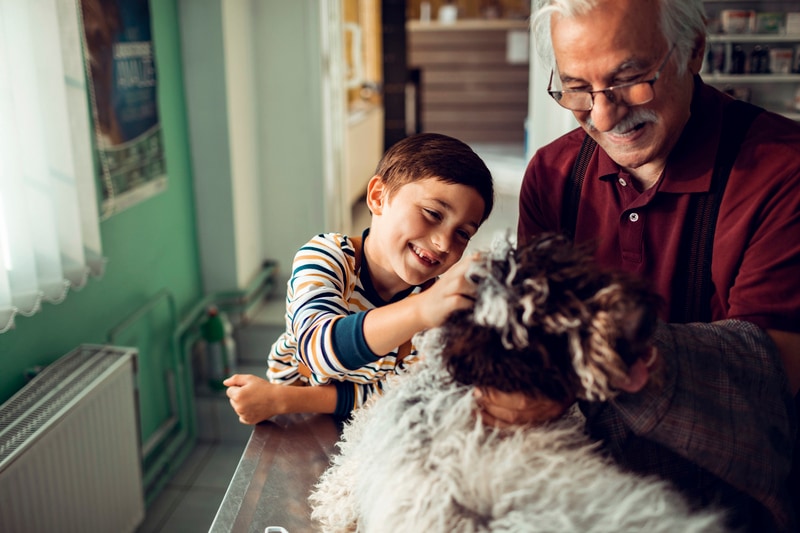Dogs’ noses are remarkable things.
Our four-legged friends experience the world through smell, the same way humans rely on sight. Here’s an excerpt from Alexandra Horowitz’s 2010 New York Times bestseller, Inside of a Dog: “Dogs don’t act on the world by handling objects or by eyeballing them, as people might, or by pointing and asking others to act on the object (as the timid might); instead, they bravely stride right up to a new, unknown object, stretch their magnificent snouts within millimeters of it, and take a nice deep sniff. That dog nose, in most breeds, is anything but subtle. The snout holding the nose projects forth to examine a new person seconds before the dog himself arrives on the scene. And the sniffer is not just an ornament atop the muzzle; it is the leading, moist headliner. What its prominence suggests, and what all science confirms, is that the dog is a creature of the nose.”
Dogs smell so well for several reasons:
First, inside the nose of both humans and dogs are bony structures called turbinates which contain most of our scent-detecting cells and the nerves that transport information about smells to the brain. According to Understanding Dogs’ Sense of Smell for Dummies: “In humans, the area containing these odor analyzers is about one square inch, or the size of a postage stamp. If you could unfold this area in a dog, on the other hand, it may be as large as 60 square inches, or just under the size of a piece of typing paper.”
In the illustration below, you can see the olfactory region inside a dog’s nose.
Second, the part of a dog’s brain that analyzes smells is 40 times larger than that of a human’s! Understanding Dogs’ Sense of Smell for Dummies says that humans have about five-million scent receptors; Dachshunds have 125 million; Beagles have 225 million; and Bloodhounds have more than 300 million!
Third, the moist exterior surface absorbs odors.
Fourth, dogs smell in “stereo!” That’s right, each nostril can operate separately from the other. This allows dogs to better determine the direction a smell comes from. Plus, dogs inhale through their nostrils, and exhale though the slits on the sides of their noses. This allows them to stir up more smells to analyze.
Finally, they also have a special organ called the “vomeronasal organ” that detects the hormones that all animals release.
What all this means is that a dog’s sense of smell can be 10,000 to 100,000 times better than ours.
Horowitz writes about how powerful a dog’s sense of smell is in her latest book, Being a Dog: “The dog knows if someone’s removed his socks in a room bigger than the gargantuan vehicle assembly building at NASA’s Kennedy Space Center in Florida, made to put space shuttles together. Any dog in the nearly four million cubic meters of Space Center would be alert to sweaty astronauts.”
And James Walker, the former director of the Sensory Research Institute at Florida State University, says in an interview with PBS’s Nova: “If you make the analogy to vision, what you and I can see at a third of a mile, a dog could see more than 3,000 miles away and still see as well.” And that’s just for a dog who’s sense of smell is “just” 10,000 times better than a humans. Imagine a dog whose sense of smell is 100,000 times better than ours!
But the most amazing thing about a dog’s sense of smell is that dogs can “tell time” by scent. Watch Horowitz’ Ted Talks video to learn how.
Increasingly, humans are relying more and more on dogs’ sense of smell to help in a number of areas. Dogs have long been used to help sniff out drugs, contraband, bombs, and victims of earthquakes, landslides, and avalanches. And of course there’s the time-honored image of Bloodhounds sniffing down escaped convicts through the Louisiana bayou!
But lately humans are looking to dogs’ sense of smell to help out in the fields of health and medicine. It’s now well-documented that dogs can detect cancer in people via odors. In a study published in the British Journal of Medicine it was reported: “Six dogs were trained to detect urine samples that belonged to patients known to have bladder cancer. While their 41 percent success rate wasn’t amazing, it was higher than the 14 percent “coincidence rate” determined by the researchers. Since then, dogs have been trained to discern other forms of cancer, including skin, prostate, lung, breast and colorectal cancers, with increasing rates of success.”
And more recently scientists have been exploring how dogs can help manage diabetes in humans: “Imagine if your dog could sense when you’re about to pass out — and do so in enough time to stop it. Now, imagine that all they need is their nose. This scenario is a reality for hundreds worldwide, including Claire Pesterfield, a pediatric diabetes nurse at Addenbrooke’s Hospital in Cambridge, United Kingdom. Pesterfield has type 1 diabetes, a form of the condition in which the pancreas is unable to produce any insulin and cannot regulate blood sugar. Her sugar levels can fall dangerously low — known as hypoglycemia — causing shakiness, confusion, disorientation and potentially unconsciousness. But her golden Labrador retriever sidekick is ready to alert her before it kicks in, day or night.”
You can read the whole report here from CNN. For Nova’s report on dogs’ sense of smell on PBS, click here. And to learn more about Alexandra Horowitz’ deep dives in the doggy world of smells, check out her website. For Urban Dog’s review of her latest book, Being a Dog, click here.





